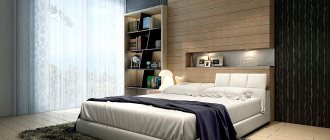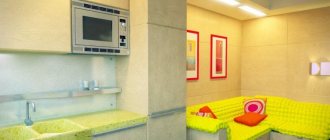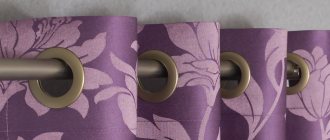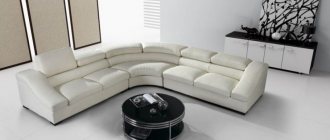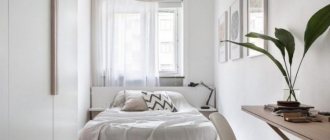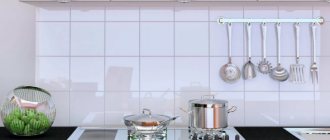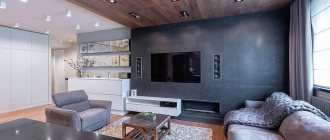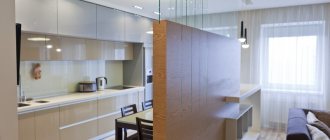Help the site, share with friends:
Let's look at a question like a niche in the wall in the living room.
What is the best way to design a niche? This is a “touchy” question for those who have a very small room.
Features of a plasterboard niche
A niche in the living room is a beautiful element of the interior. With its help, you can intelligently divide a room into zones, provide it with original lighting, and decorate it as you wish.
Very often, household appliances and decorative fireplaces are built into niches. This design eliminates the need to purchase classic cabinet furniture and also allows for significant savings. By assembling a niche in the living room with your own hands and providing it with lighting, you can easily place a TV or home theater in it.
The advantage of a niche is that, based on the square footage of the room, it is possible to make a structure of the size you need. There will also be free shelves. They can be filled with various little things or decorative elements.
With the help of a niche it is possible to hide some defects in the room and create an original interior. The niche above the sofa in the relaxation area looks very original. It can be either square or round, rectangular or made in the form of an arch (arched plasterboard). First, decide on the shape and function of the niche.
Under TV
Another popular design solution is placing a TV and other equipment, for example, audio equipment with speakers or a home theater, in a niche in the living room. This idea looks very compact, stylish and modern. Such a proposal allows you not to clutter up the area of the room and relieves the owners of wires stretched along the entire perimeter of the living room, which not only disturb the entire household, attract pets, which creates additional problems, but also greatly spoils the overall impression of the room.
Preparation of material
Before you start work, decide on the dimensions of the future structure. Make a rough drawing or drawing of the proposed niche. When you have decided on the location where the structure will be located, take the necessary measurements.
Based on the selected measurements, it is easy to purchase the necessary elements, this will reduce cash costs to a minimum. You won't be left with any extra unnecessary material. Analyze the condition of the wall, how and with what help the structure will be attached.
When measuring the proposed design, do not forget that if the niche involves placing equipment, its width should be larger. This space is necessary for natural cooling of devices to avoid their breakdown. Make sure you have all the necessary tools in your home.
For work you will need the following tools and materials:
- Profile: Rack-mounted, guide.
- The screws are not large.
- Curly and flat screwdrivers.
- Drill and dowels.
- Level and tape measure, a simple pencil.
- Hacksaw, construction knife.
- Plumb.
- Glue for plasterboard, spatula, needle roller, paint.
- All the attributes necessary for wiring (wires, lamps, sockets, switches).
Children's zone
In the photo of an apartment with a niche you can see options for arranging an alcove for a children's area. This is the optimal solution for any young family in which a child is growing; having personal space for the baby is no less important than for adults.
What kind of furniture parents will put in the children's corner depends on the age characteristics and taste preferences of its little owner. A “loft bed” is furniture that seamlessly combines a sleeping area, a workplace and a place to store things.
To buy such a bed, it is important to take into account the child’s feelings; he will have to climb to the top bunk, and parents must be sure that the child’s fear of heights is not a problem, and he will be able to climb up or down on his own.
Niche frame
The entire integrity of the structure depends on the frame.
It is important to take correct measurements, and even better, double-check them several times.
The frame system must be securely attached to the wall, the parts are clearly and securely interlocked with each other.
- Apply the resulting calculations to the wall where the niche will be located, mark all the important points on the surface of the wall.
- It is advisable to make a complete marking (drawing) on the wall, so you will visually see the outline of the proposed structure.
- Fastening straight parts is the simplest; arched or radius niches are more difficult to fasten.
- To create an arched frame, the main metal profile must be bent. This is done using metal scissors.
- Small cuts (at least five centimeters) are made on the fastening, it is bent and fastened according to your drawing.
As an option, it is possible to purchase a ready-made arched frame. The most convenient for assembling a niche is an aluminum frame.
Bonus: an original way to arrange an alcove niche
Most often, alcoves are either features of the space configuration, or are provided for at the rough stage of renovation. But there are several more design ways to get this functional interior detail.
Between the top and bottom cabinets
Take a look at the photo: this recessed niche appeared thanks to the distance left between the upper and lower cabinets in the hallway. This helped to make the most of the space, organize storage vertically, and at the same time leave a little visual lightness and air.
Niche between cabinets in the hallway
Between the wall and the closet
This alcove is also equipped without any “wet” work: it was formed thanks to the gap between the wall and the storage system.
Advice . In the same way, you can use, for example, the space between two cabinets or shelving.
Niche between wall and cabinet
Around the window
An interesting move is to visually separate the space around the window and create a kind of niche area.
Advice. It is not necessary to address the physical arrangement of the alcove (changing floor and ceiling levels and other additional cost items). You can limit yourself to highlighting the area with color, finishing materials or textile curtains.
Through niches in the partition
These holes in the partition are an effective idea for those who are thinking about how to design through niches in the apartment.
Niches replace furniture
A niche is a very beautiful decorative element. But a niche can also replace furniture. If you decorate the entire wall with a niche, place a TV, speakers in it and equip it with lighting, there is no need to purchase a cabinet.
Cute trinkets, elegant decorative elements, books and figurines will fit perfectly into the free shelves. A decorative fireplace built into a niche looks very aesthetically pleasing. Complete the niche with lighting, furnish the room with a sofa and drapery, and the room is ready.
Wardrobe
This is the dream of any fashionista, which you can make into reality if you have such a desire. Having made a decision, all that remains is to order furniture with the optimal filling option - with the required number of hangers, drawers and a mirror.
Helpful advice! To separate the dressing room from another part of the room, use sliding doors or fabric partitions.
Niche hiding the cornice
Suspended ceilings are also constructed using gypsum plasterboard material.
- When installing a false ceiling in the living room, design a niche for a curtain rod.
- It looks aesthetically pleasing and does not include unnecessary details in the interior.
- All that is visible to the eye is the material of the curtains, as if flowing from the ceiling.
Also, using a niche made of plasterboard, you can easily hide electrical wires, cords or sockets.
Ready-made niches as a specific feature of interior design
The layout of modern apartments initially implies the creation of a niche. Niches are distinguished by such qualities as spaciousness and efficiency.
Creating a specific niche depends on many factors. This is influenced by the area of the room, the number of people living in it, and the presence of this or that furniture.
The advantages of niches are obvious:
- they fit perfectly into the interior;
- they are roomy;
- visually enlarge the room in the right direction.
Niche trim
Parts for the cladding are prepared in advance and cut to specified sizes. Before attaching to the structure, all parts must be tried on. Then you need to drill holes in the structure for the screws.
The heads of the self-tapping screws should “burrow” into the gypsum board sheet; for this, chamfers are made with a drill. After attaching the sheathing, the seams and gaps are masked using putty.
Beautiful examples for inspiration
- A great example of a minimalist design is a long cabinet and simple shelves parallel to each other.
- In this example, the artificial stone finish stands out against the background of the room, but looks very appropriate and original.
Lovers of classic interiors will love the openwork frame that frames the TV. It is unlikely that a non-professional will be able to make something like this on his own, but framing workshops will come to the rescue.
A niche with a fully built-in TV looks very stylish. This design, however, can visually reduce the space of the room, so it will be ideal only in large rooms.
- Another option for decorating a niche in the hall. Everything is intertwined here: stone, shelves, a fireplace, and a small cabinet.
- The design with natural wood trim looks very expensive and high quality.
- The arched shapes give the entire interior softness and warmth. It does not look as strict as rectangular and square niches.
- And here is an option for placing a niche for a TV in the kitchen. It doesn’t take up much space and doesn’t stand out from the overall look.
- Decorating with paintings is ideal for a niche in the bedroom.
- A TV in the kitchen can also be very organically placed right above the work surface so that you can watch cooking shows and cook at the same time.
- The finish in the form of a solid wooden panel looks very interesting. This design will fit well into a living room with both a classic and minimalist style.
- Few people do this, but a low niche can be placed directly opposite the window. With a successful combination of furniture, wallpaper and decorative items, it will look very unusual.
Finishing
The method of finishing a niche does not require any special recommendations. But there are still a few recommendations.
If you want to paint a niche the same color as the wall, consider the following factors:
- Paint does not adhere well to gypsum boards
- Plaster swells when it absorbs paint.
Therefore, before painting, the structure is treated with finishing putty. It differs from analogues in that it has a micro structure. After drying, it is cleaned using fine-grained sandpaper.
- When covering a niche with wallpaper, the gypsum board is treated with primer for better fastening.
- For illumination, equip the niche with an LED strip.
- Spotlights are also applicable, but their installation is more complicated.
- When installing a niche yourself, do not be afraid to experiment. Don't forget about sound insulation.
- Fill the voids of the niches with mineral wool, otherwise the hollow structure will “buzz” when touched.
Filling the structure with cotton wool is simply necessary when installing speaker systems, otherwise the entire structure system will be subject to vibration and the sound will resonate.
Frequently asked questions about arranging a niche
How to hide a radiator?
The radiator, located in the recess of the niche, can be covered with a translucent grille, painted in the color of the room.
How to make shelves in a niche?
Decorating shelves in an alcove is a practical solution. You can make them yourself using: - special wall mounts for shelves; — metal profiles; - glue (it is worth considering that such shelves will not withstand heavy loads).
Is it worth building a TV into a niche?
Placing the plasma in a wall recess is a design decision. There are several advantages of this alcove design: -saving space; -opportunity to hide wires; - safety (no one will touch the screen in the recess).
How to choose a finish?
To be sure not to make a mistake, you should follow a few simple rules: - do not use dark colors; — it is advisable to decorate the alcove in a color that matches the rest of the room’s composition; - use only the material that will look most appropriate.
Is it possible to make lighting in a niche yourself?
If it is made of drywall, then yes. For this you will need: spotlights and electrical wires. Holes for lamps are cut in the niche, the wires are hidden behind drywall.
Is it possible to design a niche yourself?
Of course you can. The main thing is to approach the issue very seriously: - think about the location; - think about the size and shape; — select a wall; - write down measurements on paper in the form of a drawing; - consult with specialists.
Many people believe that the presence of a niche in the room is an unnecessary and disturbing part. This is wrong. On the contrary, alcoves are a great opportunity to show creativity and make a bright and at the same time practical accent of the room.
Finishing
The already fully assembled structure is brought to final finishing. The corners are reinforced with perforated corners (protection from damage during use). To do this, apply putty to the corner, press the corner into it, and remove the excess with a spatula.
Glue the seams with reinforcing mesh and seal with putty. Clean the dried putty with fine sandpaper. The screw holes are also masked with putty and rubbed over.
At the final stage, the niche is completely primed twice. The second coat of primer is applied only after the first has dried. When finishing with decorative stone or tiles, a primer is not necessary.
For cabinet
To organize a storage system in a niche, you need to select a design solution and choose the best arrangement option. It is important to equip a shallow recess in the wall with shelves and horizontal guides, having previously finished it with different materials.
Doors will help hide a closet in a niche; it is recommended to make them opaque and made of lightweight materials.
Particular attention can be paid to sliding doors, which, unlike hinged doors, allow you to save free space in the room.
Niche decor in the living room
To make your niche look original and beautiful, you can decorate it with a variety of decorative elements. You can choose different materials: wallpaper and mirrors, painting and fabric decor.
Choose a light color scheme, this will visually increase the size of the room.
As a rule, the color of the niche matches the color of the wall, but it may differ by several tones.
- Those who are especially daring can make a niche contrast with the main wall.
- Mirrors inserted into a niche will expand the space.
- An aquarium built into a niche looks aesthetically pleasing.
- An aquarium can be either with live inhabitants or decorative with lighting.
With the help of a niche, its color or shape, you can freely completely transform the living room with your own hands and realize the most daring ideas.
Design ideas
For any room
A niche is a useful and original element, regardless of its location in the house. There are many interesting ideas that can be used in almost any room.
Wardrobe
Depending on the depth of the niche, it can be designed as a place to store things. If the alcove is large enough, then you can safely design a separate small room for a wardrobe in it. If it is wide but not deep enough, then you can also place a special floor hanger in it.
Storage system
A niche can serve as a storage system in any room. Its functions vary depending on its size. For example, if the alcove is small and shallow, it can be converted into a bookshelf. Recesses in the entire wall can serve as sideboards or cabinets.
Decor compositions
Most often, mini-niches are used for decoration. Small alcoves are suitable for compositions of varying degrees of complexity. They can be decorated with paintings, vases or other small decorative items.
It is popular to decorate niches with plants. With the help of recesses you can organize even a small home garden. Indoor plants have been and remain a relevant accent of the premises.
home library
Another popular, but non-trivial solution. Having your own home library at home is a sign of intelligence. And so that the accent does not “eat up” most of the space, the best option is to place it in a niche.
Radiator
A niche near the window can be useful because you can easily hide a disturbing element such as a radiator in it.
For the bedroom
Bed space
If there is a wide recess in the room intended for sleeping, this is an excellent option for installing a bed. This solution is suitable for various types of premises. It helps create additional comfort and a feeling of enveloping space. Forms the zoning of the room. With a small room, this is a way to gain usable space.
Dressing table
Designing a small but wide recess for a dressing table is an original and elegant solution. The main thing in this design is to provide high-quality lighting.
For children's
Storage area for books and toys
The storage compartment has already been discussed in the article as the best option for organizing space. In a nursery, this design of niches plays a special role. You can place a library, textbooks, toys, collections and other small items there.
Sports section
Wide or even through niches are suitable for placing a wall bars, horizontal bar or home climbing wall.
Place of achievements
Mini niches are perfect for storing your child's cups and medals. Alcoves can also be decorated with creative objects: paintings or crafts.
For the bathroom
Bathroom alcoves can be used for both practical and aesthetic purposes.
Depending on the width and depth of the niche, it can be used for:
- decorating with aroma candles;
- storage of bath accessories;
- installing a washing machine;
- dressing table decoration.
For the living room
Center of composition
Often, alcoves are perceived as an auxiliary element of the interior, but they can also be designed as the main accent of the room.
If the niches are large, then most often sofas or cabinets are placed in them. This creates zoning of the room and also saves space.
Fireplace
The fireplace in the living room is a sophisticated element that creates elegance and at the same time comfort. The recess can be used for an electric fireplace and create a unique atmosphere of live fire even in an apartment.
If the niche is small, it can be decorated as an original decorative firewood box.
Photo of the perfect niche in the living room
A look into history
Niches were used as an interior element as early as the second century AD. Ancient architects did this by creating recesses in religious buildings, temples and places where believers in mystical teachings and cults gathered. As a rule, they played the role of recesses in the walls, open to the eyes of people. They contained various attributes of faith: statues, vases, fonts.
Ancient Roman architects used niches both in interior decoration and in exterior walls, like the famous Temple of Diana at Nîmes. Niches were used to create wonder in people and thus make the cult place even more special. The architect seemed to demonstrate that the room is transformed by magic, that this place is special, capable of causing delight and worship among believers.
Using a niche in the wall in a medieval interior
There are many examples of the use of niches in Gothic buildings, for example, Wells Cathedral. And although the era has changed, the impact on people’s feelings has not gone away. The Renaissance also used this element of architecture in the seventeenth and eighteenth centuries. At this time, any place to install an object of art was valued, and numerous niches in the houses of the rich had precisely this function - they stored paintings, sculptures and other great creations of the creators of that time.
